FW
Readymade garment exports from Pakistan in Q1 rose 15.97 per cent as compared to exports during the corresponding period last year. Exports of knitwear increased by 9.35 per cent; towels exports increased 0.9 per cent. Raw cotton exports from the country during the first quarter of the current financial year grew by 69.70 per cent.
Exports of cotton yarn were up 4.56 per cent. However, exports of cotton cloth decreased by 3.44 per cent. About 91,147 metric tons of bed wear were exported the in first quarter as compared to exports of 89,559 metric tons during the same period last year. In the first quarter of the current financial year, exports of yarn other then cotton yarn grew by 7.67 per cent.
Textile group exports from the country during the first quarter of current financial year witnessed a 7.91 per cent increase as compared to exports of the corresponding period last year.
The textile industry is the backbone of Pakistan's economy. It contributes more than 61 per cent share in the country's exports and is the largest foreign exchange earner and employment generator. The textile sector has been a major beneficiary of GSP Plus. Pakistan’s exports of textiles have increased by 55 per cent in value terms in 2016 over 2013.
Europeans want to invest in Bangladesh as they perceive the country to be a good option for ready-to-work labor force and a fast growing economy. Moreover workplace safety has improved after inspections by Accord and Alliance. However, investors face a lot of hurdles.
A foreign investor has to collect nearly 25 permissions from different agencies and departments for starting a business. Bangladesh is still languishing in the lower rungs of the World Bank’s ease of doing business. It comes in at 177 in the latest edition — only higher than Afghanistan in South Asia.
While foreign investors want a liberalised trade policy, the country still follows protectionism. There is no clear and long-term plan on power and energy. This is very important to investors for making an investment plan. Although garment shipments from Bangladesh to the EU are growing, Myanmar and Ethiopia are looking to become strong contenders for the country’s throne as the world’s second largest apparel supplier. They can be good places for garment sourcing in future as both countries have been giving incentives to attract foreign investment. Potential European investors are look for a platform in Bangladesh where they can discuss the challenges they face and seek remedy from the government such that their investment plans can go through.
India is developing standards for the technical textile sector. The market for technical textiles is expanding rapidly with new products being added in various industries. Thus it is imperative to formulate standards to accelerate the growth of the sector.
India has the capability, resource and market in the area of technical textiles and the need is to capitalise on these strengths. The market is expanding rapidly with new products being added by users in various industries. However the share of technical textiles in the domestic textile sector is very low.
Despite achieving a high growth rate, the per capita consumption of technical textiles in India is 1.7 per kg vis-a-vis 10 to 12 kg in developed countries. Technical textiles have immense potential and are considered to be the sunrise industry in India. The industry could grow with sufficient investments in technology. Development and industrialisation are the main drivers for the demand for technical textile products in a country.
Technical textiles provide new opportunities to the Indian textile industry to have a long term sustainable future. India can be positioned as a manufacturing hub for technical textiles. Demand for technical textiles is expected to stay steady during the period 2015 to 2020.
Chris Noble, the pioneering giant from Xaar, will present blending of Inkjet and Xaar technologies in the realm of 3D printing at the InPrint exhibition, Germany, November 14 to 16, 2017. The endeavor is to transform 3D printing from a prototype industry to volume production. Inkjet technology is ideally placed to deliver 3D printing’s transformation to volume manufacturing.
Digital inkjet, and specifically Xaar’s TF Technology and High Laydown Technology, is at the heart of the solution, delivering both a fast and a scalable 3D manufacturing process which is robust as well as economical.
3D printing as a manufacturing methodology encompasses a range of processes and applications. It is a highly attractive methodology, not just because it eliminates the need for tooling, but also because it provides superior geometric freedom, giving product designers much more capability, while substantially reducing product design and production lead time.
In addition, 3D printing enables customisation of products to individual consumers, decentralisation of manufacturing and reduction of storage space required for spare parts – not to mention the time, environmental and cost benefits delivered with these.
To date, 3D printing technologies have often been used to produce prototypes and one-offs. While for many businesses there is a definite value to be had in this, the opportunities with inkjet technology are now creating even greater excitement and buzz around 3D printing and its potential to deliver reliable, repeatable systems for high volume manufacturing.
Crates of fabrics valued at several crores of rupees are being returned at the borders of Bihar and Uttar Pradesh as they do not have an e-way bill. The e-way bill was made compulsory for textile deliveries under the GST introduced in July. Approximately 30 per cent of saris and dress fabrics in India are supplied to Bihar and Uttar Pradesh from other states.
GST has cast a shadow on textile trade. Traders were hopeful that the marriage season would improve their fortunes. But states like Uttar Pradesh and Bihar do not allow goods without an e-way bill. Traders are losing business which is especially pressing during the wedding season when purchases of traditional wear are at their highest peak for the year. And there is confusion surrounding the matter. Though the rule was supposed to have been implemented only in 2018, local GST officials have been enforcing it strictly at the borders of Bihar and Uttar Pradesh.
Under GST, transporters will need to carry an electronic waybill or e-way bill when moving goods from one place to another. A movement of goods of more than Rs 50,000 in value cannot be made by a registered person without an e-way bill.
Apart from strategic investors, JM Financial and Edelweiss are also understood to have shown interest in Alok Industries. The Ahmedabad bench of the NCLT had admitted Alok Industries for insolvency proceedings in July this year based on the petition by State Bank of India, which is trying to recover Rs 3,772 crores from the firm.
Alok Industries had a total debt of Rs 23,443 crores on its books as on March 2017. The company’s enterprise value stands at Rs 23,677 crores. As of September this year, the promoter shareholding in the firm stood at 28.82 per cent of which 20.75 per cent was held by Alok Knit Exports.
The company is listed on the BSE and the NSE. Shares of the company closed at Rs 4.41 on the BSE on Friday with market capitalisation of Rs 607.40 crores. The company created large capacities through debt funding to cater to global demand, but with the slowdown in international markets, it was hit badly.
"This September edition of Apparel Sourcing, Europe’s top show for global clothing and accessories and Shawls & Scarves – The Accessories Showcase that specialises in neck and shoulder accessories, recorded a 13.9 per cent increase in visitors compared to last year."

This September edition of Apparel Sourcing, Europe’s top show for global clothing and accessories and Shawls & Scarves – The Accessories Showcase that specialises in neck and shoulder accessories, recorded a 13.9 per cent increase in visitors compared to last year.
As Michael Scherpe, President, Messe Frankfurt France points out, “There are two main things to take away from this season’s show: improved standards of skills in clothing production and internationalisation.” He said feedback from production and collections showed clothing production methods are getting closer to reaching our standards. This was evident at the show. The exhibition organised by Ccipttex, ‘From Workshop to Shop’, showcasing 10 Chinese ready-to-wear brands, illustrated this perfectly.
Professionalism and quality

These are the hallmarks of this 13th session of the European trade fair for clothing and accessories held in September 2017. The ‘From Workshop to Shop’ exhibition, organised by Ccipttex had some 30 outfits from around 10 Chinese ready-to-wear brands arranged around a space, using virtual reality. These brands for women and men’s ready-to-wear are already established in China and abroad too.
Country showcase
With a good number of points of entry, since Apparel Sourcing had never hosted as many national pavilions: Sri Lanka, an alternative to India, had some specialist firms with branches abroad. Vietnam still rouses much curiosity as it offers an alternative and is very diversified, ranging as far as horn jewellery (Diep Duong). Pakistan and Bangladesh were popular on account of their huge production capacity. Nepal presented something of a surprise to many, in particular with fine finishing and design features of their cashmere products. Cambodia, the guest of honour, whose Minister for Trade, His Excellency Pan Sorasak, came to promote and encourage exports of clothing and textile products from his country. Two other opportunities for new discoveries with Myanmar, which is experiencing growing interest for sourcing, and Kyrgyzstan, which aims to assume a key role in clothing manufacture thanks to tax exemptions in Europe and the advantage of its geographical situation.
Striking highlights
The return of major Indian businesses with rich ranges of wraps, shawls and headscarves, was a driving force. Consistent, attractive offers for good design reinvigorated the show: the well-designed collection of shopping bags from the Indian FF, ‘kawaï’ (Japanese for cute) packaging from the Chinese hosiery firm Geochi, themed collections from shoes to umbrellas from WM from Shanghai, and, fabrics and products in alpaca from the Peruvian Incapalca, who, like the Nepalese at Apparel Sourcing, attracted luxury brands. Retailers and shop owners were also able to benefit from this offer for finished products.
Apparel Sourcing Paris also organised nine lectures about current topics in procurement for the clothing industry. These were: future of the clothing industry, new technologies, new skills, new countries for sourcing: the Kyrgyz Republic, Sri Lanka, Myanmar, Vietnam and Cambodia and the responsibility of prime contractors were the topics discussed over the four days of the show.
"The 5th Avantex Paris show, held from September 18-21, 2017 at Le Bourget, Paris, attained its goal of uniting players from fashion and innovation under one platform that provides a wealth of information, shows foresight and brings about positive change in the industry. Fashion brands, retailers and designers attended Avantex going beyond the stage of simple curiosity."
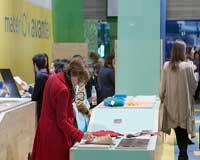
The 5th Avantex Paris show, held from September 18-21, 2017 at Le Bourget, Paris, attained its goal of uniting players from fashion and innovation under one platform that provides a wealth of information, shows foresight and brings about positive change in the industry. Fashion brands, retailers and designers attended Avantex going beyond the stage of simple curiosity.
“Avantex Paris proved to be the place where players from ready-to-wear and luxury goods were able to meet the providers of innovative, technological solutions. The variety and complementary nature of exhibitors, the daily meetings at the round tables with experts, the focus on innovative materials offered by the MateriO’ forum, the video wall, the workshops and the first session of the Avantex Fashion Pitch are all factors injecting effective and convincing stimulus in an extremely active international network for technology and fashion,” explained Michael Scherpe, president, Messe Frankfurt France.
Extensive technical textile on display
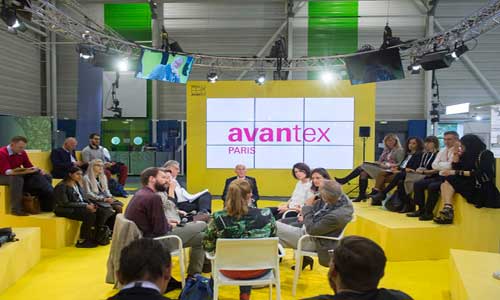
The event demonstrated the extensive range of technical textiles and finished technological products, alongside R&D projects of start-ups, who came to test their concepts in interactions with potential customers. For example, Taiwan’s Creative Tech Textile for example, which develops complex fabrics (fibres from plastic bottles and oyster shells for example) while observing style and trends. “‘Our fashion goal has been met,” said their representative Lucy Hsiao after meeting a good number of firms.
Material was the star, since the Parisian materials library matériO’, one of the trade show’s partners, presented latest developments for clothing and accessories. Future prospects forum showed supple wood-based fabrics, frog skin and fish skin leather, leather from innards, conductive fabrics, wearable sculpture and many other talking points. To & Guy showcased a revolutionary process for stylists and designers to position and test motifs on a product in 3D without needing to know every detail of the pattern.
Institutional participation
Omar Cherkaoui, Member, ESITH cluster and school, remarked, “If Morocco is chiefly considered as the country for sub-contracting, the presence of the Moroccan Technical Textiles Cluster C2TM at a trade fair like Avantex, which is dedicated to innovation, has helped to make people take a second look at what the country has to offer. Some 30 professionals showed a clear interest in our collaborative and innovative approach.” Colleges and schools, breeding grounds for tomorrow’s fashion, are delighted with the numerous contacts they made throughout the four days: Ensad Paris, the Hochschule Albstadt Sigmaringen and Chongqing University from China were able to present their research and work by their students.
Avantex Fashion Pitch, the ambitious competition held via the WiRATE platform and organised by the trade fair, rewarded start-ups that offered solutions that are representative of the segments at the show and whose products and services won the most votes. Torq Labs won the prize for Clothing & Accessories with a range of lightweight leggings for sports that help to prevent knee injuries. Pyratex, in the Material & Components category, won admission and a listing in matériO’ for its collection of fabrics in natural fibres that have beneficial effects for the skin and body. Reflect, in the Prototype Studio category, won a prize for a dedicated item in the Magazine Modelab.
The Agora at Avantex Paris, apart from the Fashion Pitch, hosted eight lectures and round tables on diverse subjects, from development of functional fabrics to the digital era, new patterns of behaviour on social media, procurement and standards for electronic textiles etc. Agora also organised the Wall of Avantex with a programme of videos about the products and projects that mix innovative technology and fashion.
"Messe Frankfurt France organized Texworld Paris from September 18 to 21, 2017. The show focused on materials, components and trimmings for the fashion and accessories industry recorded a 13.9 per cent increase in visitors compared to last year. After two years of lacklustre performance, buyers were in need of renewal and a change in fashion codes. And as Michael Scherpe, President, Messe Frankfurt France said, “We found the September 2017 show to be extremely busy. From the very first day of the show, there was a wind of change blowing through the shows."
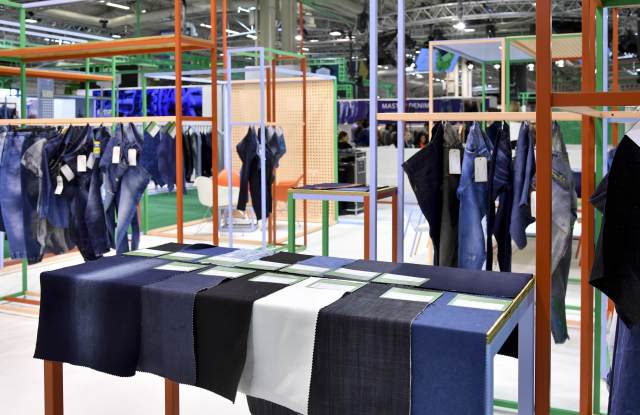
Messe Frankfurt France organized Texworld Paris from September 18 to 21, 2017. The show focused on materials, components and trimmings for the fashion and accessories industry recorded a 13.9 per cent increase in visitors compared to last year. After two years of lacklustre performance, buyers were in need of renewal and a change in fashion codes. And as Michael Scherpe, President, Messe Frankfurt France said, “We found the September 2017 show to be extremely busy. From the very first day of the show, there was a wind of change blowing through the shows. Very determined visitors descended on the General Forum for trends with its artistic backdrop, which provided an excellent showcase for the colours of the individual shows and above all the choice and original characteristics of the weavers. Exhibitors welcomed the attendance by representatives from some very high-end segments, even from the European luxury sector. The same goes for the return by Americans (+19,38 per cent for the US) and contacts who were more than satisfied as they rediscovered the show.”
Strong county participation
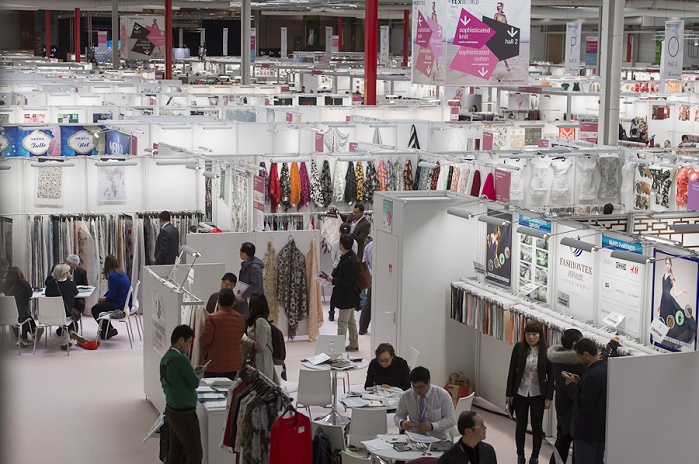
European brands remain keen on the solutions offered by the firms exhibiting at Apparel Sourcing, Avantex, Shawls & Scarves – The Accessories Showcase, Texworld Et Texworld Denim Paris (+15 per cent) and the top five countries reflect this trend: France, UK, Spain, Italy and Turkey. Germany grabbed the next spot, up by 18.7 per cent, and Belgium up by +4.8 per cent. At 83 per cent (+3 per cent) internationally, the shows at Paris Le Bourget clearly demonstrate their predominant position in global business for textiles, clothing and accessories. As Paris remains worthwhile as ever, participants have realised that they are called on to adapt to meet the demands of ‘Western’ fashion and refine their collections, their marketing strategy and the service they offer in order to increase business and become creative. The categories at the show fulfilled their purpose and the segments for embroideries, lace and elaborate knits, which attracted a good number of exhibitors, really drew the crowds.
China (with the largest contingent of weavers at the show) was one of the main attractions, as confirmed by Zhang Tao, secretary general, Ccipt Tex. The improvement in business models of domestic firms, as advocated by the Chinese government, aims to continue working towards genuine fashion products, to develop technical innovation and to emphasise sustainable development. Upscaling, was also noticed in the wide variety of products from Turkish weavers, Indian range of cotton and embroidery, South Korean prints, the comprehensive offer, even technical, from Indonesian exhibitors all drew visitors’ interest.
For businesses, Texworld Paris remains a major trade fair for the industry. September edition provided them with an opportunity to meet loyal customers face-to-face, while forging new deals. It was an unique occasion to explore the markets of the North and South American continents, as the Czech shirting specialist La Linea remarked. Business Beyond Borders, a partnership that fosters business contacts between players in the textile and clothing industry and small manufacturing firms, set up by Eurochambres, met with resounding success. They held over 200 meetings in their dedicated space involving 258 companies from 42 countries.
Texworld Denim
With almost 80 exhibitors for materials and clothing production, Texworld Denim lived up to its promise as a meeting place for businesses that is entirely dedicated to denim. Finding fabrics and manufacturers in one area made it easier for prime contractors to make contact and then conclude projects successfully from start to finish, and for exhibitors to network with each other. The Texworld Denim area is bound to expand with a marketing policy and its own trade show strategy.
Conference expanse
Three conferences and round table discussions took place at Texworld Paris: the sector for future clothing; Ex-aequo, the trends for autumn/winter 18/19; new technologies and new skillsets. The Outlook for denim in the 21st and 22nd centuries was also organised at Texworld Denim. Texworld Paris also organised fashion shows in the Catwalk area by Esmod Paris, the designers Fiona Fondadouze and Santiago Lomelli, the prize-winners from the Dinan International Festival for Young Fashion Designers, and Eymeric François’ iconic collection for 17/18. The next Texworld and Texworld Denim will be held from February 11 – 14, 2018. Be there to be a part of a bigger & better trade show.
"More than ever, the eco-efficiency of the textile & clothing industry has been under scanner with many associations taking steps towards enhancing sustainability in the apparels industry. This was the topic of discussion at the recently held exhibit in New York at Museum of Modern Art (MOMA). It focused on rethinking how businesses approach each stage of product development. Ideated by Paola Antonelli and Michelle Millar Fisher, ‘Is Fashion Modern?’ analysed the impact that items of clothing and accessories have had on the world today, including what were considered revolutionary items including, the ‘little black dress’ and Levi's 501 jeans."
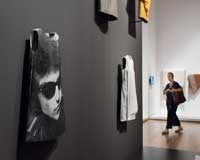
More than ever, the eco-efficiency of the textile & clothing industry has been under scanner with many associations taking steps towards enhancing sustainability in the apparels industry. This was the topic of discussion at the recently held exhibit in New York at Museum of Modern Art (MOMA). It focused on rethinking how businesses approach each stage of product development. Ideated by Paola Antonelli and Michelle Millar Fisher, ‘Is Fashion Modern?’ analysed the impact that items of clothing and accessories have had on the world today, including what were considered revolutionary items including, the ‘little black dress’ and Levi's 501 jeans. The exhibit also featured another important offering: providing a large-scale illustration depicting Glasgow Caledonian's Fair Fashion Center and a process called the Quantum Redesign of Fashion.
Sustainability taking centerstage
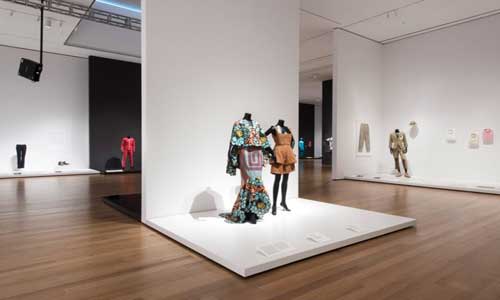
Fashion is a $2.5 trillion industry considered a top user of natural resources and polluter of the communities in which it operates. It ought to attract the attention of eco police aiming to shape a better tomorrow. MoMA exhibit used research from the Fair Fashion Center and enlisted famed data artist Giorgia Lupi to provide an important visualisation of the scope of fashion industry, especially in identifying the 16 sub-businesses that constitute the fashion system – from agriculture and chemicals to real estate and waste management. The special artwork outlined how changes in these businesses can impact other areas, but at the same time help deliver on the United Nations Sustainable Development Goals. As with many complex issues, it is envisioned that in depicting viable solutions can create an industry that is a respectful and regenerative ecosystem supporting people, planet and profits.
Quantum redesign of fashion
The Quantum Redesign of Fashion featured in this exhibit was the work stream of the Fair Fashion Center (FFC) that has developed the Quantum Redesign of Fashion, which has in just two years focussed uniquely on achieving sustainability through a profitable means and shifting the conversation to more sustainable business practices. Working with more than 237 global brands and retailers, the FFC is trying to tackle impacts created by the value chain and developing actionable solutions that align with the reality of the industry, in key issues like end of use, regenerative agriculture, circular economy, and transport.
UN’s role in fashion
The UN Global Compact recently invited a young group from Copenhagen's Youth Fashion Summit to the United Nations. The students explored how the (SDGs) allow companies to align their sustainability goals with actionable solutions: from gender equality and poverty reduction to responsible consumption and climate action. This year, the students were asked to transform their ideas for corporate action on the SDGs into a proposed UN draft resolution - the first linked to the fashion sector.












